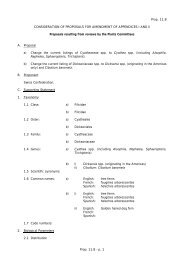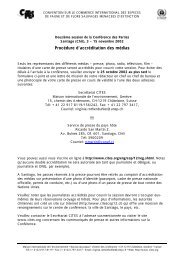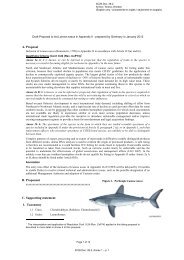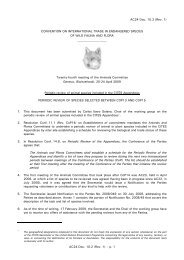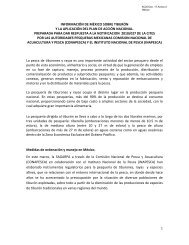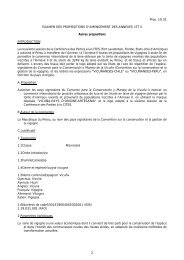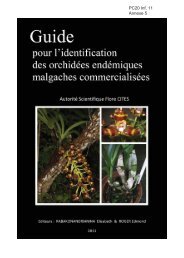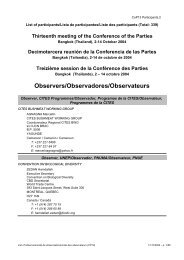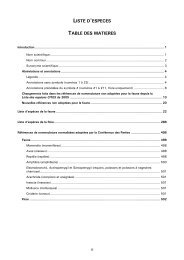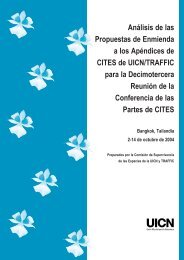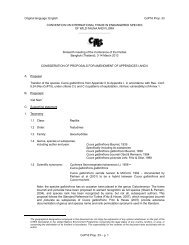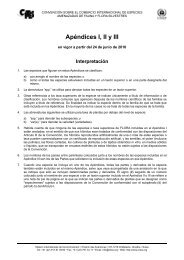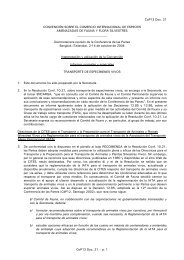Uromastyx dispar - Cites
Uromastyx dispar - Cites
Uromastyx dispar - Cites
Create successful ePaper yourself
Turn your PDF publications into a flip-book with our unique Google optimized e-Paper software.
<strong>Uromastyx</strong> <strong>dispar</strong> Heyden, 1827<br />
FAMILY: Agamidae<br />
COMMON NAMES: Sudan <strong>Uromastyx</strong>, Sundanese <strong>Uromastyx</strong> (English)<br />
AC22 Doc. 10.2 – p. 67<br />
AC22 Doc. 10.2<br />
Annex 6c<br />
GLOBAL CONSERVATION STATUS: Currently being assessed by IUCN Global Reptile Assessment.<br />
SIGNIFICANT TRADE REVIEW FOR: Algeria, Chad, Mali, Mauritania, Sudan<br />
Range States selected for review<br />
Range State Exports* Urgent, possible or Comments<br />
(1994-2003) least concern<br />
Algeria 0 Least concern No trade reported<br />
Chad 0 Least concern No trade reported<br />
Mali 125,362 Possible concern Primary exporter for the species; no systematic population monitoring<br />
in place or basis for ensuring non-detrimental nature of exports was<br />
available; Mali also exports considerable quantities of other <strong>Uromastyx</strong><br />
species.<br />
Mauritania 0 Least concern No trade reported<br />
Sudan<br />
*Excluding re-exports<br />
2 Least concern Insignificant exports<br />
SUMMARY<br />
<strong>Uromastyx</strong> <strong>dispar</strong> occurs in a broad band across northern Africa, from Mauritania and the southern part<br />
of Western Sahara east to northern Sudan and (probably) extreme southern Egypt. It is found in arid<br />
areas with rocky slopes in mountain valleys.<br />
<strong>Uromastyx</strong> species are internationally traded for the pet trade. All species of <strong>Uromastyx</strong> were listed in<br />
CITES Appendix II in 1977. U. <strong>dispar</strong>, commonly known as the Sudan <strong>Uromastyx</strong>, currently dominates<br />
the international trade in <strong>Uromastyx</strong> species, with high levels of reported exports from 1998 onwards.<br />
The USA is the main reported importer of the species.<br />
The main exporter of U. <strong>dispar</strong> over the period 1994-2003 was Mali. There is little information on the<br />
size of the population of this species within Mali or elsewhere and therefore it is not possible to<br />
determine whether harvesting for international trade is detrimental to wild populations. However, if it<br />
occurs at population densities comparable to those of other <strong>Uromastyx</strong> species, its population may<br />
number several hundred thousand at minimum, and quite possibly several million, so that exports are<br />
likely to be well be within sustainable limits. However, in the absence of concrete information on the<br />
basis of non-detriment findings, the high level of trade in this species from Mali should be considered of<br />
Possible Concern. Zero or insignificant exports from other range states are of Least Concern.<br />
SPECIES CHARACTERISTICS<br />
The CITES Nomenclature Committee recommends adoption of Wilms (2001) as the basic reference for<br />
<strong>Uromastyx</strong> (CITES, 2004). This recognises <strong>Uromastyx</strong> <strong>dispar</strong> as a separate species from U. acanthinura,<br />
although it has been in the past considered a subspecies of the latter. It considers U. maliensis, described<br />
by Joger and Lambert (1996) and still treated by some as a separate species, as a synonym for U. <strong>dispar</strong>.<br />
<strong>Uromastyx</strong> <strong>dispar</strong>, commonly known in the pet trade as the Sundanese <strong>Uromastyx</strong>, has a brownish head<br />
with light spots, the back pale brown with dark spots and legs dark brown. Adults reach an average<br />
length of 36 cm (Walls, 1996).<br />
The species occurs in arid areas with rocky slopes in mountain valleys. It can be found in palm oases and<br />
fields such as pastureland (IUCN, in prep). This species has a fragmented range and occurs at altitudes<br />
from 100 up to 2,000 m in Algeria, Chad, Mali, Mauritania, Sudan, Western Sahara (UNEP –WCMC,<br />
2006; IUCN, in prep.). Some consider that the species also occurs in Somalia (Bartlet, 2003).
Little specific information is available of the biological characteristics and ecology of U. <strong>dispar</strong> in the wild.<br />
<strong>Uromastyx</strong> speices in general are oviparious with clutch sizes between 8 to 20 eggs. Eggs are laid in<br />
female burrow systems in the late spring-early summer or at the beginning of the dry season and hatch<br />
after an incubation period of eight to ten weeks (Bahiani et al., 1997; Schliech et al., 1996; Zug et al.,<br />
2001). Hatchlings stay within the burrow system for several weeks to months before leaving to establish<br />
their own burrows (Peters, 1971). The smaller <strong>Uromastyx</strong>, of which U. <strong>dispar</strong> is one, may reach sexual<br />
maturity in two or three years (Gray, 1995). Wild-caught <strong>Uromastyx</strong> specimens have been known to live<br />
for 20 years in captivity with estimates of a life span of 25 years (Bartlet, undated).<br />
Like other <strong>Uromastyx</strong> species, U. <strong>dispar</strong> appears to be entirely or very largely herbivorous as an adult;<br />
juveniles, in captivity at least, feed enthusiastically on insects and other invertebrates if these are offered<br />
(Gray, undated; Pough et al., 2001; Schleich et al., 1996).<br />
Few population data are available although preliminary information from the IUCN Global Reptile<br />
Assessment (IUCN, in prep.) indicates that it can be locally common. Vernet et al. (1988) in a study in a<br />
highly arid environment at Beni-Abbes in Algeria estimated densities of the very closely related U.<br />
acanthinura at 0.1-1.0 individuals per hectare. Robinson (1995) found population densities of the similar<br />
and also closely related U. aegyptius several times that (4.4-6.3 individuals per hectare) in a still arid but<br />
somewhat more productive environment in Kuwait.<br />
In the absence of population information we sought to estimate the probable order of magnitude of the<br />
species’ population using available information on distribution and densities. From the estimated<br />
distribution provided by Wilms and Böhme (2000), the extent of occurrence is some 200 million<br />
hectares. Given that the species reportedly has a fragmented range and using the lower end of the<br />
population density estimates given above, it seems likely that the population numbers many hundreds<br />
of thousands of individuals, and quite possibly several million.<br />
The draft of the IUCN Global Reptile Assessment indicates that the species is threatened by overharvesting<br />
for the international pet trade, and subsistence use for food and medicinal purposes. Habitat<br />
loss is not noted as a current or predicted future threat to this species (IUCN, in prep.).<br />
Participants at a workshop in Malaga assessed the species within the range States bordering the<br />
Mediterranean as Near Threatened, citing a significant decline because of over-collection for food,<br />
medicine and the international pet trade, and habitat degradation, thus making the species close to<br />
qualifying for Vulnerable under Criteria A2cd. (IUCN, in prep.).<br />
INTERNATIONAL TRADE<br />
<strong>Uromastyx</strong> species are internationally traded for the pet trade. All species of <strong>Uromastyx</strong> were listed in<br />
CITES Appendix II in 1977.<br />
Table 1: Exports excluding re-exports of live wild <strong>Uromastyx</strong> <strong>dispar</strong> from range States, 1994-2003<br />
Export<br />
Country<br />
1994 1995 1996 1997 1998 1999 2000 2001 2002 2003 Total<br />
Mali 2433 967 18012 13778 15303 26955 29114 18800 125362<br />
Sudan 2 2<br />
Total 0 0 2433 967 18012 13778 15303 26955 29116 18800 125364<br />
(Source: CITES trade statistics derived from the CITES Trade Database, UNEP World Conservation<br />
Monitoring Centre, Cambridge, UK.)<br />
COUNTRY ACCOUNTS<br />
Algeria<br />
Status:<br />
Occurs in south-western Algeria.<br />
AC22 Doc. 10.2 – p. 68
Management and trade:<br />
No trade in U. <strong>dispar</strong> was reported although between 1994 and 1997 16 specimens recorded as<br />
<strong>Uromastyx</strong> spp. were re-exported from Algeria, which may have been U. <strong>dispar</strong>. After this time Algeria’s<br />
only <strong>Uromastyx</strong> exports were U. acanthinura. Trade is of Least Concern.<br />
Chad<br />
Status:<br />
Recorded from northern and eastern Chad in the regions of the Tibesti and Ennedi Mountains (Wilms and<br />
Fagre, 1995).<br />
Management and trade:<br />
No trade reported in U. <strong>dispar</strong>. Chad has exported one specimen of <strong>Uromastyx</strong> acanthinura over the 10year<br />
period. However, Chad is not considered to be a range State of U. acanthinura and therefore this<br />
may have been U. <strong>dispar</strong>, which is the only <strong>Uromastyx</strong> species known to occur in the country and<br />
considered by some to be a sub-species of U. acanthinura. In the absence of reported trade in this<br />
species and low levels of trade at the genus level, trade from Chad is considered Least Concern.<br />
Mali<br />
Status:<br />
Occurs in northern and eastern Mali. No population data available.<br />
Management and trade:<br />
The most significant exporter of <strong>Uromastyx</strong> <strong>dispar</strong> was Mali, from which the gross trade of 125,362<br />
specimens was reported. Particularly high quantities were exported from 1998 to 2003. In addition, Mali<br />
has exported 23,397 specimens of <strong>Uromastyx</strong> spp. between 1996 and 2002, which could be U. <strong>dispar</strong><br />
or U. geyri, the only two species known to occur in the country. Furthermore, Mali has recorded the<br />
export of U. acanthinura, which is not known to be present in Mali, although U. <strong>dispar</strong> and U. geryi are<br />
considered sub-species of U. acanthinura by some authors. In addition Mali reported the export of 1,297<br />
captive-bred specimens in 2002.<br />
Exports in 2004 have declined to around 10,000, although it is not clear whether this is part of a longterm<br />
trend or not.<br />
From 2001 to 2005 Mali set export quotas of 32,000 specimens of U. geyri, for which trade was<br />
considerably lower than for U. <strong>dispar</strong>. However, a quota of 30,000 U. <strong>dispar</strong> has been set for 2006 and<br />
the quota for U.geyri reduced to 2,000.<br />
Export may be within sustainable limits but population information is lacking and it appears that the wild<br />
population is not monitored, no quotas were set for this species until 2006 and no information has been<br />
found on whether non-detriment findings have been established and, if so, on what basis. Therefore the<br />
trade in this species from Mali is of Possible Concern.<br />
Mauritania<br />
Status:<br />
No information available.<br />
Management and trade:<br />
No exports have been recorded from Mauritania. Ten specimens of U. acanthinura were exported from<br />
Mauritania in 2000. Some have identified Mauritania as a range State for U. acanthinura, alternatively<br />
these could be specimens of U. <strong>dispar</strong>, which is considered by some as sub-species of U. acanthinura. In<br />
AC22 Doc. 10.2 – p. 69
the absence of reported trade in this species and low levels of trade at the genus level, trade from<br />
Mauritania is considered Least Concern.<br />
Sudan<br />
Status:<br />
Recorded in northern Sudan (Welch, 1982) and western Sudan, with a single record from Wadi Halfa<br />
(Baha El Din in litt., 2006).<br />
Management and trade:<br />
Sudan exported two specimens of U. <strong>dispar</strong> in 2002. Exported specimens of U. acanthinura, U. ornata, U<br />
ocellata and U. aegyptia have also been recorded. Trade in U. <strong>dispar</strong> from Sudan is of Least Concern.<br />
Other countries NOT SELECTED FOR REVIEW<br />
The range of U. <strong>dispar</strong> is also believed to extend to the Adrar Souttouf region of Western Sahara (IUCN in<br />
prep.).<br />
CAPTIVE BREEDING<br />
Table 2: Reported trade in captive-bred (C ) and ranched, (R ) specimens (re-exports excluded)<br />
Export<br />
1994 1995 1996 1997 1998 1999 2000 2001 2002 2003 Total<br />
Country Source<br />
Mali C 1297 1297<br />
El Salvador C 16 4732 1880 6628<br />
Ghana R 100 100<br />
USA R 20 20<br />
Total 0 0 0 0 0 0 0 36 6029 1980 8045<br />
(Source: CITES trade statistics derived from the CITES Trade Database, UNEP World Conservation<br />
Monitoring Centre, Cambridge, UK.)<br />
Mali reported the export of 1,297 captive-bred specimens in 2002. As well as re-exporting U. <strong>dispar</strong>,<br />
Ghana has started to export specimens as ranched. El Salvador’s reported exports included over 6,500<br />
specimens recorded as captive–breed in 2002 and 2003. However, imports into El Salvador of this<br />
species were only recorded from 2001 (1,560 individuals; 3,000 in 2002; 500 in 2003). Given that the<br />
genus is difficult to breed in captivity, current captive-breeding facilities in these countries should be<br />
verified to ensure exports recorded as captive-bred or ranched are not wild exports or re-exports. Noting<br />
that wild-collected specimens are not always easily acclimatised and mortality amongst them is not<br />
uncommon, some hobbyists recommend keeping captive-bred or ranched rather than wild-caught<br />
specimens. Captive-bred U. <strong>dispar</strong> may therefore sell for higher prices than wild specimens, and captivebreeding<br />
may gradually replace wild harvesting as techniques improve (Bartlet, 2003).<br />
PROBLEMS IDENTIFIED THAT ARE NOT RELATED TO THE IMPLEMENTATION OF ARTICLE IV, PARAS<br />
2(a), 3, or 6(a)<br />
The taxonomy of the genus <strong>Uromastyx</strong> and the geographical distribution of individual taxa require<br />
clarification.<br />
REFERENCES<br />
Bahiani, M., Gernigon-Spychlowicz, T., Hammouche, S., and Khannar, F. (1997), Life History of the palm tree lizard<br />
or Dob (<strong>Uromastyx</strong> acanthinurus) Herpetology ’97; Abstracts of the Third World Congress of Herpetology 2-10<br />
August 1997, Prague, Czech Republic. Eds. Zbynek Rocek and Scott Hart.<br />
Bartlet, R.D. in litt. (undated). In: Gray, R.L, (undated). The natural history, husbandry and captive propogation of the<br />
Moroccan Spiny-tailed Lizard (<strong>Uromastyx</strong> acanthinurus)<br />
http://www.kingsnake.com/uromastyx/caresheets/MOROCCON1.htm Viewed December 2005.<br />
AC22 Doc. 10.2 – p. 70
Bartlet, R.D. (2003). Spiny-Tailed Agamids (<strong>Uromastyx</strong> and Xenagama) Barron’s, Hauppauge, NY, USA.<br />
Baha El Din, S., in litt,. (2006) to IUCN Species Programme.<br />
CITES (2004). Report of the Nomenclature Committee (CoP13 Doc. 9.3.1). Thirteenth meeting of the Conference of<br />
the Parties Bangkok (Thailand), 2-14 October 2004.<br />
Gray, R.L. (undated). The Natural History, Husbandry and Captive Propagation of the Moroccan Spiny-tailed Lizard<br />
(<strong>Uromastyx</strong> acanthinurus) http://www.kingsnake.com/uromastyx/caresheets/MOROCCON1.htm Viewed December<br />
2005.<br />
Gray, R.L (1995). Captive husbandry of ornate spiny-tailed lizards. Reptiles 3: 64-76.<br />
IUCN (in prep). Global Reptile Assessment species accounts.<br />
Joger, U. and Lambert, R.K. (1996). Analysis of the herpetofauna of the Republic of Mali. Annotated<br />
inventory, with description of a new <strong>Uromastyx</strong> (Sauria: Agamidae). Journal of African Zoology,<br />
110: 21-51.<br />
Peters, G. (1971). Die inttragenerischen Gruppen und die Phylogenese der Schetterlingsagamen (Agamidae:<br />
Leiolepis) Zool. Jb. Syst. 98:11-130. In: Zug, G.R. Vitt, L.J., Caldwell, J.P., (2001). Herpetology: An Introductory<br />
Biology of Amphibians and Reptiles- Second edition. Academic Press Inc, Academic Press Inc., San Diego,<br />
California, USA.<br />
Pough, F.H., et al., (2001). Herpetology – Second Edition Prentice Hall Inc., New Jersey. USA.<br />
Robinson, M. D. (1995). Food plants and energetics of the herbivorous lizard, <strong>Uromastyx</strong> aegyptius microlepis, in<br />
Kuwait. Journal of the University of Kuwait (Science): 22 255-261.<br />
Schleich, H. H., Kästle, W. and Kabisch, K. (1996). Amphibians and Reptiles of North Africa. Koeltz, Königstein,<br />
Germany.<br />
UNEP-WCMC (2006). CITES Species Database, UNEP World Conservation Monitoring Centre, Cambridge, UK.<br />
http://www.cites.org/eng/resources/species.html Viewed January 2006.<br />
Vernet, R., Lemire, M. and Grenot, C.J. (1988). Ecophysiological comparisons between two large Saharan lizards,<br />
Uromastix acanthinurus (Agamidae) and Varanus griseus (Varanidae). J. Arid Environ., 14: 187-200.<br />
Welch , K.R.G. (1982). Herpetology of Africa: A Checklist and Bibliography of the Orders Amphisbaenia, Sauria and<br />
Serpents. Robert E Krieger Publiching Company, Florida, USA.<br />
Wilms, T. and Böhme, W. (2000). Revision of the <strong>Uromastyx</strong> acanthinura species group, with description of a new<br />
species from the central Sahara (Reptilia: Sauria: Agamidae). Zool. Abh. Staatl. Mus. Tierk. Dresden 518: 73-104.<br />
Wilms, T. and Fagre, M. (1995). http://www.kingsnake.com/uromastyx/caresheets/species.htm Viewed December<br />
2005.<br />
Wilms, T. (2001). Dorschwanzagamen. Second edition. Herpeton, Offenbach, Germany.<br />
Zug, G.R. Vitt, L.J., Caldwell, J.P. (2001). Herpetology: An Introductory Biology of Amphibians and Reptiles- Second<br />
edition. Academic Press Inc., San Diego, California, USA.<br />
AC22 Doc. 10.2 – p. 71




